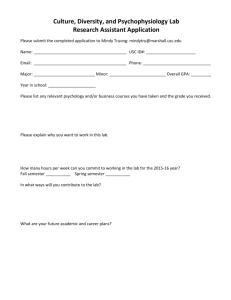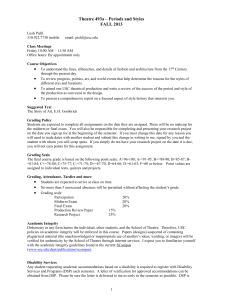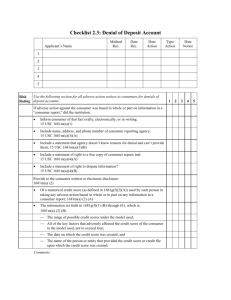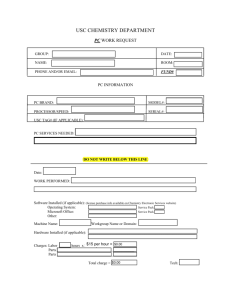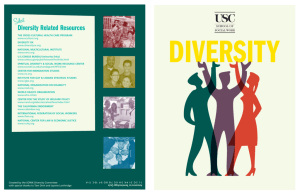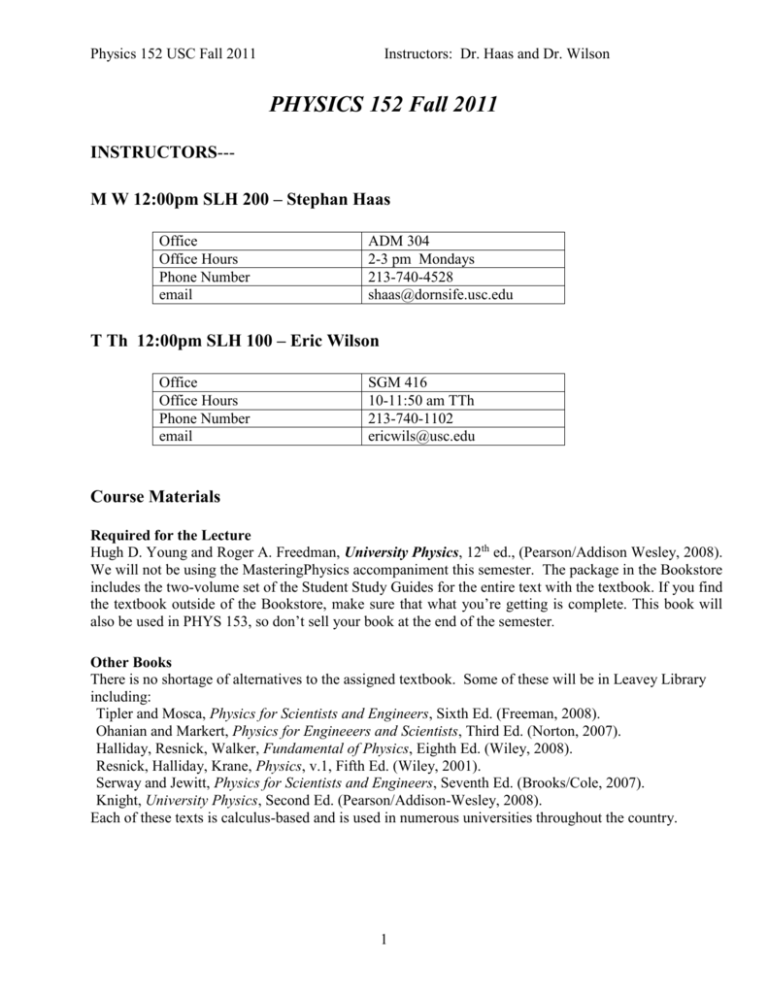
Physics 152 USC Fall 2011
Instructors: Dr. Haas and Dr. Wilson
PHYSICS 152 Fall 2011
INSTRUCTORS--M W 12:00pm SLH 200 – Stephan Haas
Office
Office Hours
Phone Number
email
ADM 304
2-3 pm Mondays
213-740-4528
shaas@dornsife.usc.edu
T Th 12:00pm SLH 100 – Eric Wilson
Office
Office Hours
Phone Number
email
SGM 416
10-11:50 am TTh
213-740-1102
ericwils@usc.edu
Course Materials
Required for the Lecture
Hugh D. Young and Roger A. Freedman, University Physics, 12th ed., (Pearson/Addison Wesley, 2008).
We will not be using the MasteringPhysics accompaniment this semester. The package in the Bookstore
includes the two-volume set of the Student Study Guides for the entire text with the textbook. If you find
the textbook outside of the Bookstore, make sure that what you’re getting is complete. This book will
also be used in PHYS 153, so don’t sell your book at the end of the semester.
Other Books
There is no shortage of alternatives to the assigned textbook. Some of these will be in Leavey Library
including:
Tipler and Mosca, Physics for Scientists and Engineers, Sixth Ed. (Freeman, 2008).
Ohanian and Markert, Physics for Engineeers and Scientists, Third Ed. (Norton, 2007).
Halliday, Resnick, Walker, Fundamental of Physics, Eighth Ed. (Wiley, 2008).
Resnick, Halliday, Krane, Physics, v.1, Fifth Ed. (Wiley, 2001).
Serway and Jewitt, Physics for Scientists and Engineers, Seventh Ed. (Brooks/Cole, 2007).
Knight, University Physics, Second Ed. (Pearson/Addison-Wesley, 2008).
Each of these texts is calculus-based and is used in numerous universities throughout the country.
1
Physics 152 USC Fall 2011
Instructors: Dr. Haas and Dr. Wilson
Required for the Laboratory
(a) Science Notebook (National Notebook 43-645). Any equivalent notebook with quadrille ruled
pre-numbered pages bound into the notebook, with identically numbered pages for copies (either
carbon copies and carbonless forms) is acceptable.
(b) Laboratory Manual (Dept. of Physics & Astronomy, Fall 2011). The Laboratory Manual is
provided on the lab’s Blackboard site. You do not need to print it, though, of course, you can if
you want to. While you will need to read the Manual in advance of your lab meeting, online
reading is sufficient because a copy will be provided for your reference in the lab meeting room.
(c) Calculator with linear and statistical functions
NOTES on LABORATORY – The laboratory is run by Dr. Gokhan Esirgen. His email is
esirgen@usc.edu. Office is KAP-B19 and his office phone is 213-740-1138. The laboratory grade is
worth 20% of your total course grade. The labs meet in the first week of classes. It is very important
that you report to lab in the first week because this is when you will learn everything you need to know
like getting your lab manual, lab notebook, and how to do your lab reports, where and how to hand
them in etc…you will meet your lab TA who will have an email, office, office hrs. etc…
HOMEWORK – The homework will consist of written problems designed by the instructors. The
homework will be posted on Blackboard in the assignments section and collected during the last lecture
of every week unless otherwise specified in class. Late homework is not accepted. Homework is not
accepted before it is due. Homework can only be handed in during lecture. You may not scan it and
email it. You may not slide it under your professor’s door. If you cannot come to lecture to hand in
your homework, you can have a friend hand it in for you.
MIDTERMS – There will be two midterms. The first midterm will be Thursday, Sep. 29 at 5pm. The
second midterm will be Thursday, Nov. 10 at 5pm (locations TBA). Each midterm will be worth 15%
of your total course grade. There are no make-ups for exams. Do not miss a midterm. The exam
questions are based on the lectures and the homework. Again if you miss a lecture, you might miss a
problem that could be an exam question.
EXAM Final – The final exam is on Dec. 12 from 4:30pm – 6:30 pm. The location will be announced.
The final will cover the entire course and will be worth 30% of your total course grade. The final is an
opportunity to show your understanding of material that you may not have shown mastership on in your
midterms. If you do unusually well on your final exam it will help you in the total course grade by
virtue of the fact that it is worth 30% of your course grade.
2
Physics 152 USC Fall 2011
Instructors: Dr. Haas and Dr. Wilson
GRADING SUMMARIZED:
Item
Homework
Midterm One
Midterm Two
Final Exam
Laboratory Grade
Total
Percent towards total course grade
20
15
15
30
20
100
LECTURE NOTES – One of the best ways of learning physics is to copy your lecture notes over neatly
and clearly and see if you can understand them without the instructor filling in the narrative. This
combined with reading your book is a tremendous exercise for learning the material. If you do this you
will find that the homework is a lot easier. The problem you are faced with is that this takes time. You
have to set a lot of time aside to study your physics. It simply takes time on your part. There is no way
to get around that fact. However the material is very exciting once you begin to gain confidence in
understanding it.
DISABILITIES – The inclusion of the following statement has been requested by the DSP office:
“Students who need to request accommodations based on a disability are required to register each
semester with the Disability Services and Programs. In addition, a letter of verification to the instructor
from the Disability Services and Programs is needed for the semester you are enrolled in this course. If
you have any questions concerning this procedure, please contact the course instructor and Disability
Services and Programs at (213) 740-0776, STU 301.”
ASSISTANCE – In addition to lecture, the instructor and Lab TA’s have office hours that can be used
to answer questions you may have about concepts or particular homework problems. Also the solutions
to written homework problems are posted on Blackboard after the homework is turned in.
ADDITIONAL ASSISTANCE:
(a) Supplemental Instruction Program http://www.usc.edu/dept/LAS/si
Supplemental Instruction (SI) is an academic program organized by the College of Letters, Arts,
and Sciences, designed to improve student performance in this course and in several other
traditionally difficult courses. It is free and does not require academic credit. Each week there
will be several sessions led by an SI leader who will be working together with the instructor and
attending the same lectures as you do. For further information, contact Judy Haw at 740-5295.
3
Physics 152 USC Fall 2011
Instructors: Dr. Haas and Dr. Wilson
(b) Study Groups
One of the most effective ways to learn new material is to teach it to others. To this end, we
encourage you to work together in learning the material, and in doing homework assignments. If
you have friends also enrolled in the course, in any section, feel free to discuss homework
problems, approaches to solutions, and even solutions, though again you are cautioned not to
simply copy each other’s solutions.
(c) Viterbi Academic Resource Center http://viterbi.usc.edu/tutoring
The Viterbi Academic Resource Center office is located in the Ronald Tutor Hall of
Engineering, Room 222, and provides two kinds of services. It provides free individual and
group tutoring with tutors screened by the School of Engineering. Its hours are posted at
viterbi.tutoring@usc.edu. Regular review sessions are planned. For more information contact
the Engineering Student Affairs Office, RTH 110. Other contacts: 740-3381,
viterbi.tutoring@usc.edu.
(d) Tutors
The Department of Physics and Astronomy does not recommend tutors. The principal function
of a tutor is to enforce a regular study of course material. This function, however, is served as
well by working together with other students in the course.
4
Physics 152 USC Fall 2011
Instructors: Dr. Haas and Dr. Wilson
OUTLINE OF TOPICS COVERED, APPROXIMATE WEEKLY SCHEDULE:
Week
1-5
Dates
Chapters
Aug. 22 – Sep. 22 Ch. 21-26
6
Sep. 27 – Sep. 29 Midterm One
Thurs. Sep. 29 5pm
Location TBA
Oct. 4 – Nov. 3
Ch. 27-30
7-11
Topics
Coulomb’s Law
Electric Fields
Gauss Law
Electric Potential
Capacitance, Dielectrics
Current, Resistance
DC Circuits
Topics of Weeks 1-5
Lorentz Force
Magnetic Fields
Ampere’s Law
Faraday’s Law
Inductance
Nov. 8 – Nov. 10 Midterm Two
Thurs. Nov. 10 5pm Topics of Weeks 7-11
Location TBA
13-15
Nov. 15 – Dec. 1 Ch. 31, 32 Review 15 AC Circuits
Wave Review
Electromagnetic Waves
Poynting Vector
Final Exam Dec. 12
4:30pm – 6:30pm
Cumulative
Location TBA
covering entire material
12
5
Physics 152 USC Fall 2011
Instructors: Dr. Haas and Dr. Wilson
Important Dates Fall Semester 2011
Aug. 22
Aug. 22-26
Sept. 5
Sept. 9
Sept. 9
Sept. 9
Sept. 9
Sept. 13
Nov. 11
Nov. 23-26
Dec. 2
Dec. 3-6
Dec. 7-14
Dec. 15-Jan. 8
Fall semester classes begin in Session 001
Late registration and change of program
Labor Day, university holiday
Last day to register and add classes for Session 001
Last day to drop a class without a mark of "W," except
for Monday-only classes, and receive a 100% refund for
Session 001
Last day to change enrollment option to Pass/No Pass
or Audit for Session 001
Last day to purchase or waive tuition refund insurance
for Session 001
Last day to drop a Monday-only class without a mark
of "W" and receive a 100% refund or change to
Pass/No Pass or Audit for Session 001
Last day to drop a class with a mark of W for Session
001
Thanksgiving recess
Fall semester classes end
Study days
Final examinations
Winter recess
6

